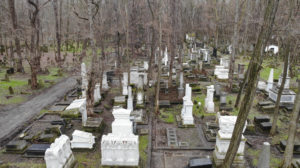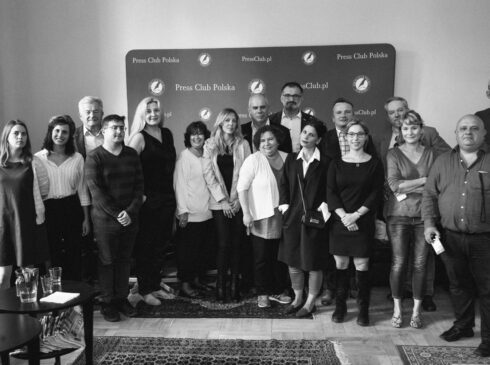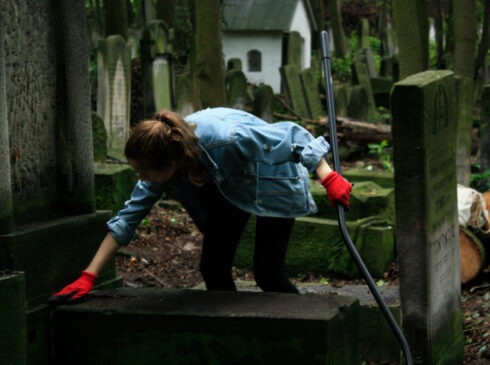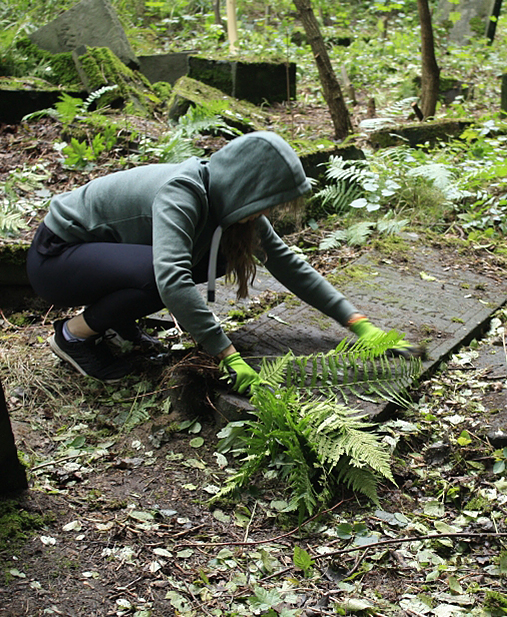Conservation works in section 20. Jewish Cemetery in Warsaw
The twentieth and twenty-sixth quarters were established in 1859 as a result of the efforts of Warsaw assimilationists. They are the burial place of many outstanding people who left a permanent mark on the history of Warsaw and even the history of Poland. There we will find mausoleums and graves of Warsaw industrialists (Lesser, Bergson, Levy, Wawelberg, Fajans), booksellers and publishers (Orgelbrand, Glücksberg, Merzbach, Gabriel Centnerszwer, Jakub Mortkowicz and others), bankers, doctors, writers, political activists and social. The graves of people who made contributions to the Jewish community and to Warsaw differ. Often, there was a type of monument that allowed us to recognize whether the deceased belonged to a traditional or assimilated (so-called “progressive”) family. Rich assimilated families erected monuments to their deceased in various styles prevailing in a given era (Egyptian, modernist, Empire, etc.). The tombstones were made not of sandstone, which was the most common material for traditional graves, but of granite or various varieties of marble, sometimes imported from abroad. On these graves we most often find inscriptions in Polish and German, sometimes Russian and Hebrew, as well as ornaments taken from non-Jewish traditions. It happened that assimilated families ordered a monument to be made by non-Jewish artists. The Jewish necropolis in Wola is an exceptionally rich gallery of sepulchral art. In addition to traditional tombstones and ohels, simple in their architecture, tombs of sophisticated form and high artistic value began to be built over the graves of wealthy entrepreneurs, merchants, political and social activists, as well as artists. The tombstones made of crystalline marble, located in the twentieth and twenty-sixth sections, dating from the 19th and early 19th centuries, have a varied, multi-element form. The most frequently used motifs are: a column with a smooth or fluted shaft, in some cases entwined with a wreath, sometimes it is broken off and placed on a pedestal and base, an obelisk placed on a pedestal and base, a stele, a sarcophagus or a stone coffin. Due to the unique, representative nature of both plots, the tombstones located there should be given special care. Neglected for many years, they require immediate conservation intervention, which will stop the progressing destruction and thus preserve them in their original form for future generations.
Location of works
The twentieth and twenty-sixth quarters were established in 1859 as a result of the efforts of Warsaw assimilationists. They are the burial place of many outstanding people who left a permanent mark on the history of Warsaw and even the history of Poland. There we will find mausoleums and graves of Warsaw industrialists (Lesser, Bergson, Levy, Wawelberg, Fajans), booksellers and publishers (Orgelbrand, Glücksberg, Merzbach, Gabriel Centnerszwer, Jakub Mortkowicz and others), bankers, doctors, writers, political activists and social. The graves of people who made contributions to the Jewish community and to Warsaw differ. Often, there was a type of monument that allowed us to recognize whether the deceased belonged to a traditional or assimilated (so-called “progressive”) family. Rich assimilated families erected monuments to their deceased in various styles prevailing in a given era (Egyptian, modernist, Empire, etc.). The tombstones were made not of sandstone, which was the most common material for traditional graves, but of granite or various varieties of marble, sometimes imported from abroad. On these graves we most often find inscriptions in Polish and German, sometimes Russian and Hebrew, as well as ornaments taken from non-Jewish traditions. It happened that assimilated families ordered a monument to be made by non-Jewish artists. The Jewish necropolis in Wola is an exceptionally rich gallery of sepulchral art. In addition to traditional tombstones and ohels, simple in their architecture, tombs of sophisticated form and high artistic value began to be built over the graves of wealthy entrepreneurs, merchants, political and social activists, as well as artists. The tombstones made of crystalline marble, located in the twentieth and twenty-sixth sections, dating from the 19th and early 19th centuries, have a varied, multi-element form. The most frequently used motifs are: a column with a smooth or fluted shaft, in some cases entwined with a wreath, sometimes it is broken off and placed on a pedestal and base, an obelisk placed on a pedestal and base, a stele, a sarcophagus or a stone coffin. Due to the unique, representative nature of both plots, the tombstones located there should be given special care. Neglected for many years, they require immediate conservation intervention, which will stop the progressing destruction and thus preserve them in their original form for future generations.
List of objects undergoing work:
- Zofia Goldstand’s tombstone, Plot 20, Row 1, Number 6;
- Felicja Goldstand’s gravestone, Plot 20, Row 1, Number 8;
- Gravestone of Stefania Flam, Plot 20, Row 1, Number 13;
- Gravestone of Eleonora Broder, Plot 20, Row 1, Number 1;
- Józefa Guttmann’s gravestone, Plot 20, Row 1, Number 15;
- Tombstone of Mikołaj Guttmann, Plot 20, Row 1, Number 16
- Helena Bersohn’s gravestone, Plot 20, Row 2, Number 1;
- Zygmunt Bersohn’s tombstone, Plot 20, Row 2, Number 3;
- Justyna Berg’s gravestone, Quarter 20, Row 2, Number 4;
- Stanisław Salinger’s tombstone, Quarter 20, Row 2, Number 5;
- Melania Janasz’s tombstone, Plot 20, Row 2, Number 7;
- Tadeusz Flaum’s gravestone, Plot 20, Row 2, Number 9;
- Teofila Rosenblum’s gravestone, Plot 20, Row 2, Number 10;
- Alfred Bersohn’s gravestone, Plot 20, Row 3, Number 1;
- Adolf Gradenwitz’s tombstone, Plot 20, Row 3, Number 3;
- Kazia Gradenwitz’s gravestone, Plot 20, Row 3, Number 4;
- Regina Gradenwitz’s gravestone, Plot 20, Row 3, Number 5;
- Karolina Flatau’s gravestone, Plot 20, Row 3, Number 6;
- Henryk Rosen’s tombstone, Plot 20, Row 3, Number 9;
- Szymon Rosen’s gravestone, Plot 20, Row 3, Number 10.
The works are carried out in accordance with the permission of the Masovian Provincial Conservator of Monuments and under the supervision of the Rabbinical Commission for Cemeteries.
___
Conservation work is carried out by the Cultural Heritage Foundation from funds obtained thanks to a grant from the Minister of Culture and National Heritage to the perpetual fund of the Cultural Heritage Foundation intended for work on the historic Jewish Cemetery at ul. Okopowa in Warsaw.
![]()









